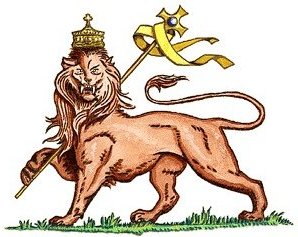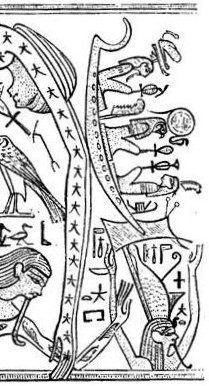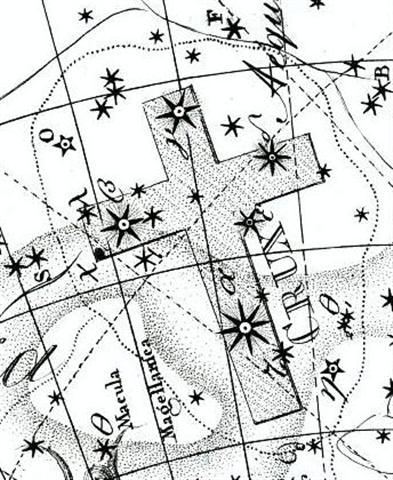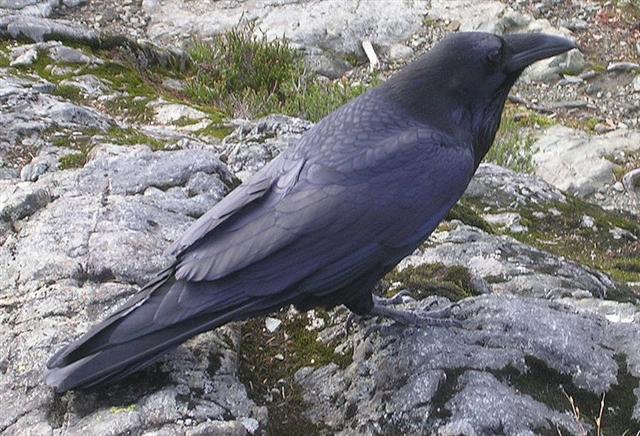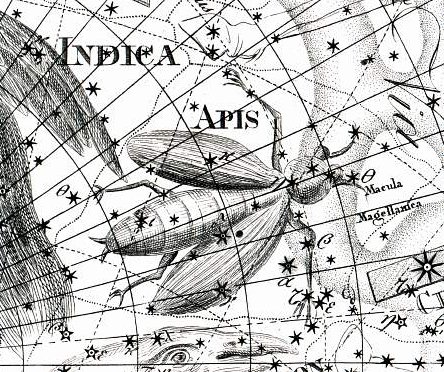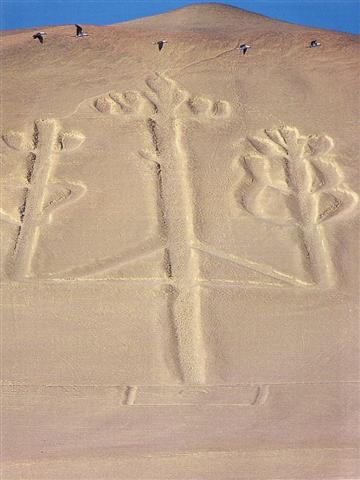21. Currently the Raven would be visible in the nights around the northern autumn equinox = the southern spring equinox. In myth the spring and autumn equinoxes were similar but opposite in character: ... The Katawihi distinguish two rainbows: Mawali in the west, and Tini in the east. Tini and Mawali were twin brothers who brought about the flood that inundated the whole world and killed all living people, except two young girls whom they saved to be their companions. It is not advisable to look either of them straight in the eye: to look at Mawali is to become flabby, lazy, and unlucky at hunting and fishing; to look at Tini makes a man so clumsy that he cannot go any distance without stumbling and lacerating his feet against all obstacles in his path, or pick up a sharp instrument without cutting himself ... ... There was no water in the village. The lakes and rivers were dry. Raven and Crow, two young girls who were having their first menstrual courses, were told to go and draw water from the ocean. Finding the journey too long, Raven decided just to urinate into her basket-bucket. She decieved no one and was severly scolded. Crow returned much later but with drinking water. As a punishment, Raven was condemned never to find water in the summer; only in winter would she find something to drink. For that reason the Raven never drinks during the hot months; she speaks with a raucous voice because of her dry throat ...
Counting from my assumed era for rongorongo (AD 1842) back in time to 10800 BC we will find the precessional depth to be around (1842 + 10800) / 71 = 178 right ascension days, or around 365 - 187 days. Day 187 is July 6:
The first glyph in the G text corresponds to the 19th Chinese station Net with the added hint Crow.
Whereas a Raven appears to be totally black the Crow exhibits also the colour white. ... Hala qaattsi ttakkin-gha, a voice said: 'Come inside, my grandson.' Behind the fire, at the rear of the house, was an old man white as a gull. 'I have something to lend you', said the old man. 'I have something to tell you as well. Dii hau dang iiji: I am you.' Slender bluegreen things with wings were moving between the screens at the back of the house. Waa'asing dang iiji, said the old man again: 'That also is you.' ...
The Black-shining Raven (Alchita, α Corvi) was not 183 days later than Ain (the Bull's Eye). Instead May 25 (290 / 2) + 183 = 328 (November 24). ... Take the lower part of a gourd or hula drum, rounded as a wheel (globe), on which several lines are to be marked and burned in, as described hereafter. These lines are called na alanui o na hoku hookele, the highways of the navigation stars, which stars are also called na hoku ai-aina, the stars which rule the land. Stars lying outside these three lines are called na hoku a ka lewa, foreign, strange, or outside stars. The first line is drawn from Hoku-paa, the fixed or North Star, to the most southerly star of Newe, the Southern Cross. (This hour circle coincides with the meridian on an evening in June, when it would divide the visible sky into halves.) The portion (of the sky) to the right or east of this line (the observer is evidently assumed to be facing north) is called ke ala ula a Kane, the dawning or bright road of Kane, and that to the left or west is called ke alanui maawe ula a Kanaloa, the much-traveled highway of Kanaloa. (Kane and Kanaloa were important gods in the Polynesian pantheon, Kane being associated with light, Kanaloa with darkness.) Then three lines are drawn east and west, one across the northern section indicates the northern limit of the Sun (corresponding with the Tropic of Cancer) about the 15th and 16th days of the month Kaulua (i.e., the 21st or 22nd of June) and is called ke alanui polohiwa a Kane, the black-shining road of Kane. The line across the southern section indicates the southern limit of the Sun about the 15th or 16th days of the month Hilinama (December 22) and is called ke alanui polohiwa a Kanaloa, the black-shining road of Kanaloa. The line exactly around the middle of the sphere is called ke alanui a ke ku'uku'u, the road of the spider, and also ke alanui i ka Piko a Wakea, the way to the navel of Wakea (the Sky-father). Between these lines are the fixed stars of the various lands, na hokupaa a ka aina. (These are the stars which hang suspended in the zeniths of the Polynesian islands most of which lie within the tropics.) On the sides are the stars by which one navigates ... But couting from Hyadum II (*64) and 123 right ascension days ahead, we will arrive at *64 + *123 = *187 (Acrux):
The precession had moved Alchita around 64 days ahead in the Sun calendar, from JULY 18 (199) to day 199 + 64 = 263 (September 20). 263 (Raven) - 145 (May 25 → Crow) = 118 = 472 / 4 = 354 - 236.
Emansor loitered at a fig-tree, which could have corresponded to the Tree of Life, which in turn could have referred to the Southern Cross: ... Whittier said, in his Cry of a Lost Soul: 'The Cross of pardon lights the tropic skies'; which is correct for our day, as it is not now entirely visible above 27º 30' of north latitude. It was last seen on the horizon of Jerusalem - 31º 46' 45'' - about the time that Christ was crucified. But 3000 years previously all its stars were 7º above the horizon of the savages along the shores of the Baltic Sea, in latitude 52º 30' ... Von Humboldt adds: The two great stars, which marks the summit and the foot of the Cross, having nearly the same right ascension, it follows that the constellation is almost perpendicular at the moment when it passes the meridian. This circumstance is known to the people of every nation situated beyond the Tropics or in the southern hemisphere. It has been observed at what hour of the night, in different seasons, the Cross is erect or inclined. It is a time piece, which advances very regularly nearly four minutes a day, and no other group of stars affords to the naked eye an observation of time so easily made. How often have we heard our guides exclaim in the savannahs of Venezuela and in the desert extending from Lima to Truxillo, 'Midnight is past, the Cross begins to bend' ... Crux lies in the Milky Way, - here a brilliant but narrow stream three or four degrees wide, - and is noticeable from its compression as well as its form, being only 6º in extent from north to south, and less in width, the upper star a clear orange in color, and the rest white; the general effect being that of a badly made kite, rather than a cross ... ... the bird, being sent with a cup for water, loitered at a fig-tree till the fruit became ripe, and then returned to the god with a water-snake in his claws and a lie in his mouth, alleging the snake to have been the cause of the delay. In punishment he was forever fixed in the sky with the Cup and the Snake; and, we may infer, doomed to everlasting thirst by the guardianship of the Hydra over the Cup and its contents. From all this came other poetical names for our Corvus - Avis Ficarius, the Fig Bird; and Emansor, one who stays beyond his time; and a belief, in early folk-lore, that this alone among birds did not carry water to its young ... ... Eridhu, or Eri-duga, the Holy City, Nunki, or Nunpe, one of the oldest city in the world, even in ancient Babylonia, was that kingdom's flourishing port on the Persian Gulf, but, by the encroachments of the delta, its site is now one hundred miles inland. In its vicinity the Babylonians located their sacred Tree of Life ...
... Two thousand miles of empty ocean and the deeps of the Chile Basin separate Easter Island from the west coast of South America. A due-east course would lead voyagers from the island to make landfall in Chile. But a course somewhat to the north of east might bring a ship eventually to the safe haven of the bay of Paracas in Peru, which lies on a meridian exactly 180 degrees of longitude east - and west - of the temples of Angkor in Cambodia. We came across the water from the north in a small open boat, skirting the arid Balestas islands, now a marine sanctuary, and heading for the Paracas peninsula, where rolling sandstone hills and escarpments drop steeply into the sea. From more than 15 kilometers off-shore we had been able to make out the so-called 'Candelabra of the Andes', first through binoculars and then in direct sight. It lay due south of us, carved into a sloping cliff, looming ever larger in our field of view as we approached. The scholarly consesus is that this huge earth-diagram could easily be 2000 years old and is most likely to have been the work of the same people who created the better-known Nazca lines which are found inland, some 300 kilometers to the south. This 'Nazca culture', about which very little is known, is thought to have flourished from the second century BC until about 600 AD. The 'Candelabra' has a rectangular, box-like base, enclosing a circle, out of which rises the representation of a wide central vertical bar, more than 240 meters in length, running north to south. This is crossed, about one-third of the way up, by a triangular contraption running east to west for some 120 meters, supporting two shorter vertical bars. All three bars are surmounted by curious patterns generally interpreted as flames or rays of light. Because of its auspicious geodetic location half-way round the world from Angkor and 108 degrees west of Giza - sites that both 'resemble the sky' by modelling specific constellations on the ground - we have naturally considered the possibility that the Candelabra could be a work of celestial imitation. What particularly invites this enquiry is the orientation of the diagram. It is set very closely to true north-south, the meridian of the sky, the great dividing-line across which astronomers in all cultures have traditionally observed the 'transits' of stars. The Candelabra was intended by its designers to be seen from the north. Indeed, there is no other perspective from which it may be satisfactorily viewed: the observer must face south towards the sloping escarpment on which it is carved. Examining the diagram from the base up naturally draws the eyes towards the southern sky above the escarpment, and specifically towards the south meridian. Although it may be entirely coincidental, computer simulations tell us that at around the hour of midnight on the March equinox 2000 years ago - the epoch in which the Candelabra was probably made - the constellation known as Crux (the Southern Cross) would have been seen lying on the south meridian at an altitude of 52 degrees. At that moment an observer positioned on a boat as we now were, about a kilometre north of the Candelabra, would have seen the Southern Cross suspended in the sky directly above the great cliff diagram ...
The role of the Raven was profound, and 263 - 236 = 27 was the number of days he came late.
... Alice was beginning to get very tired of sitting by her sister on the bank and of having nothing to do: once or twice she had peeped into the book her sister was reading, but it had no pictures or conversations in it, 'and what is the use of a book', thought Alice, 'without pictures or conversations?' So she was considering, in her own mind (as well as she could, for the hot day made her feel very sleepy and stupid), whether the pleasure of making a daisy-chain would be worth the trouble of getting up and picking the daisies, when suddenly a White Rabbit with pink eyes ran close by her. There was nothing so very remarkable in that; nor did Alice think it so very much out of the way to hear the Rabbit say to itself 'Oh dear! Oh dear! I shall be too late!' (when she thought it over afterwards it occurred to her that she ought to have wondered at this, but at the time it all seemed quite natural); but, when the Rabbit actually took a watch out of its waistcoat-pocket, and looked at it, and then hurried on, Alice started to her feet, for it flashed across her mind that she had never before seen a rabbit with either a waistcoat-pocket, or a watch to take out of it, and was just in time to see it pop down a large rabbit-hole under the hedge. In another moment down went Alice after it, never once considering how in the world she was to get out again ...
And it was Raven who had discovered Mankind when walking on the empty and lifeless Long Sandbank:
|
||||||||||||||||||||||||||||||||||||||||||||||||||||||||||||||||||||||||||||||||||||||||||||||||||||||||||||||||||||||||||||||||||||||||||||||||||||||||||||||||||||||||||||||||||||||||||||||||||||||||||||||||||||||||||||||||||||||||||||||||||||||||||||



